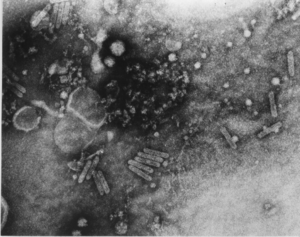Badnavirus: Difference between revisions
No edit summary |
No edit summary |
||
| (11 intermediate revisions by 3 users not shown) | |||
| Line 1: | Line 1: | ||
[[Category:Short pages]] | |||
[[Category:Incomplete Pages]] | |||
{{Curated}} | |||
{{Viral Biorealm Genus}} | |||
[[Image:badnavirus.gif|thumb|right|Badnavirus. From [http://www.ncbi.nlm.nih.gov/ICTVdb/WIntkey/Images/b1.gif ICTVdB Descriptions]]] | [[Image:badnavirus.gif|thumb|right|Badnavirus. From [http://www.ncbi.nlm.nih.gov/ICTVdb/WIntkey/Images/b1.gif ICTVdB Descriptions]]] | ||
| Line 5: | Line 10: | ||
===Higher order taxa=== | ===Higher order taxa=== | ||
Viruses; Retro-transcribing viruses; Caulimoviridae; Badnavirus | Viruses; Retro-transcribing viruses; [[Caulimoviridae]]; ''Badnavirus'' | ||
===Species=== | ===Species=== | ||
Banana streak | ''Banana streak virus'', ''Sugarcane bacilliform virus'', ''Commelina yellow mottle virus'', ''Cacao swollen shoot virus'' (examples) | ||
==Description and Significance== | ==Description and Significance== | ||
Viruses in the ''Badnavirus'' genus are plant pararetroviruses, meaning they use reverse transcription of an RNA intermediate in order to replicate. The name "Badnavirus" comes from "'''ba'''cilliform '''DNA''' virus." | |||
One species of badnavirus, the banana streak badnavirus, is the causative agent of viral leaf streak of banana and plantain. The virus was identified in Morocco in 1985. | |||
(sources: Ndowora et al., [http://www.dpvweb.net/notes/showgenus.php?genus=Badnavirus Descriptions of Plant Viruses]) | |||
==Genome Structure== | ==Genome Structure== | ||
The genome is | The genome is non-segmented and contains a single molecule of circular double-stranded DNA. The complete genome is 7200-7600 nucleotides long. The genome has terminally redundant sequences that have direct terminal repeats and are reiterated internally in inverted form. The genome is a relaxed circular molecule due to a site-specific discontinuity in each strand of DNA. (sources: [http://www.ncbi.nlm.nih.gov/ICTVdb/ICTVdB/00.015.0.05.htm ICTVdB], Briddon et al.) | ||
==Virion Structure of a Badnavirus== | ==Virion Structure of a Badnavirus== | ||
The virions of a badnavirus consist of a | The virions of a badnavirus consist of a non-enveloped, elongated, icosahedral capsid. The capsid is bacilliform and the capsid shells of the virions are composed of multiple layers. Virions are either 95-130 nm or 60-900 nm in length, and 24-30-35 nm in diameter. (source: [http://www.ncbi.nlm.nih.gov/ICTVdb/ICTVdB/00.015.0.05.htm ICTVdB]) | ||
==Reproduction Cycle of a Badnavirus in a Host Cell== | ==Reproduction Cycle of a Badnavirus in a Host Cell== | ||
==Viral Ecology & Pathology== | ==Viral Ecology & Pathology== | ||
Badnaviruses are plant viruses. The transmission vector for badnaviruses are arthropods of the order Hemiptera in the families Aleyrodidae, Aphididae, Cicadellidae, and Pseudococcidae. (source: [http://www.ncbi.nlm.nih.gov/ICTVdb/ICTVdB/00.015.0.05.htm ICTVdB]) | |||
==References== | ==References== | ||
Briddon et al. "Analysis of the Sequence of Dioscorea Alata Bacilliform Virus; Comparison to other Members of the Badnavirus Group." ''Virus Genes'' 18.3 (1999): 277-283. | |||
[http://www.dpvweb.net/notes/showgenus.php?genus=Badnavirus Descriptions of Plant Viruses: Notes on Genus: Badnavirus.] | |||
[http://www.ncbi.nlm.nih.gov/ICTVdb/ICTVdB/00.015.0.05.htm ICTVdB - The Universal Virus Database, version 4. http://www.ncbi.nlm.nih.gov/ICTVdb/ICTVdB/] | |||
Ndowora et al. "Evidence That Badnavirus Infection in Musa Can Originate from Integrated Pararetroviral Sequences." ''Virology'' 255.2 (1999): 214-220. | |||
Latest revision as of 14:38, 28 September 2015
A Viral Biorealm page on the genus Badnavirus

Baltimore Classification
Higher order taxa
Viruses; Retro-transcribing viruses; Caulimoviridae; Badnavirus
Species
Banana streak virus, Sugarcane bacilliform virus, Commelina yellow mottle virus, Cacao swollen shoot virus (examples)
Description and Significance
Viruses in the Badnavirus genus are plant pararetroviruses, meaning they use reverse transcription of an RNA intermediate in order to replicate. The name "Badnavirus" comes from "bacilliform DNA virus."
One species of badnavirus, the banana streak badnavirus, is the causative agent of viral leaf streak of banana and plantain. The virus was identified in Morocco in 1985.
(sources: Ndowora et al., Descriptions of Plant Viruses)
Genome Structure
The genome is non-segmented and contains a single molecule of circular double-stranded DNA. The complete genome is 7200-7600 nucleotides long. The genome has terminally redundant sequences that have direct terminal repeats and are reiterated internally in inverted form. The genome is a relaxed circular molecule due to a site-specific discontinuity in each strand of DNA. (sources: ICTVdB, Briddon et al.)
The virions of a badnavirus consist of a non-enveloped, elongated, icosahedral capsid. The capsid is bacilliform and the capsid shells of the virions are composed of multiple layers. Virions are either 95-130 nm or 60-900 nm in length, and 24-30-35 nm in diameter. (source: ICTVdB)
Viral Ecology & Pathology
Badnaviruses are plant viruses. The transmission vector for badnaviruses are arthropods of the order Hemiptera in the families Aleyrodidae, Aphididae, Cicadellidae, and Pseudococcidae. (source: ICTVdB)
References
Briddon et al. "Analysis of the Sequence of Dioscorea Alata Bacilliform Virus; Comparison to other Members of the Badnavirus Group." Virus Genes 18.3 (1999): 277-283.
Descriptions of Plant Viruses: Notes on Genus: Badnavirus.
ICTVdB - The Universal Virus Database, version 4. http://www.ncbi.nlm.nih.gov/ICTVdb/ICTVdB/
Ndowora et al. "Evidence That Badnavirus Infection in Musa Can Originate from Integrated Pararetroviral Sequences." Virology 255.2 (1999): 214-220.
